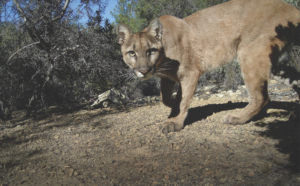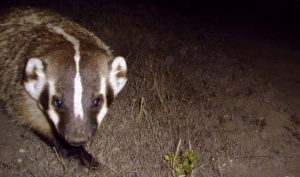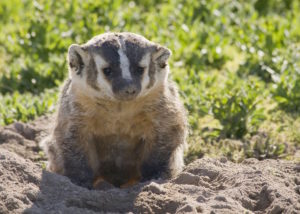Where suburban houses give way to grassy fields on the outskirts of Petaluma, a dedicated group of neighbors has spent ten years working to preserve habitat for the elusive American badger.
Now, the efforts of the all-volunteer Paula Lane Action Network (PLAN) may pay off in a big way: PLAN, the City of Petaluma, and the Sonoma County Agricultural Preservation and Open Space District have forged an innovative partnership that, if successful, will result in the purchase of the 11-acre property and creation of the new Paula Lane Open Space Preserve.
The treeless, hilly parcel is one of only ten places in Sonoma County where badgers have been documented, says wildlife biologist Kim Fitts. These stripe-faced grassland dwellers, listed by the state as a Species of Special Concern, have been recorded on the property for more than 100 years. Many other animals also use the area for habitat, foraging, and as a corridor between other open spaces.
All of that was threatened when the land was slated for development a decade ago. “These creatures have no voice,” says Susan Kirks, PLAN’s chair. “All along we’ve known that if we were not successful in saving this land, it would mean the cutting off of a wildlife corridor and the end of badger habitat here.”
When I visited Paula Lane at twilight, a red fox bounded across the field and slipped under a fence. Minutes later, a buck wandered by. Dark, dusty-mouthed burrows hinted at the presence of badgers, but unsurprisingly I didn’t see any of the nocturnal animals.
“Badgers have a very large territory,” says Fitts. But they don’t wander aimlessly. Typically, they move between favorite hunting spots, returning to the same places again and again, and passing that tradition down through generations.
“You can think of it like having ten summer homes,” Fitts said. “They are very faithful to those certain areas.”
These reclusive animals play a large role in California’s grasslands: They keep rodent populations in check, and their burrows provide refuge to many animals such as tiger salamanders, skunks, red-legged frogs, and burrowing owls.
Though badgers were once common in grasslands throughout California, their numbers have dwindled over the last century due to a combination of development, habitat loss, and hunting. Historically, badgers were considered a nuisance because of their habit of burrowing in pastures, creating trip hazards for livestock. Today habitat loss and fragmentation are the animals’ main problems.
“Grassland habitat is easiest to build on, so it’s been developed the most,” Fitts says. “Grapes and houses go in really nicely, with no trees to cut down.”
The effort to create the Paula Lane Open Space Preserve began in 2000 when neighbors found out about the planned housing development. “It started with 18 people in a neighbor’s living room,” says Kirks. “Now we have 50 to 70 volunteers we can call on when we need to.”
For the last ten years, PLAN has opposed development proposals, reviewed documents, and organized the purchase effort. The group also raised money for consultants and orchestrated the partnership with the city and open space district. But if the property purchase succeeds, PLAN will do much more than that: The volunteer organization will be fully in charge of managing the property for the city.
“We stepped in and said we’ll do it,” Kirks said. “If we want this land saved, we have to do whatever is necessary.”
The original idea was to leave the property as it is to serve as wildlife habitat, with the tenants who live in a small rental house near the road staying on as caretakers.
Over the years, however, the proposal grew more complex–in part to make it more attractive to funders. Now the plan for the preserve includes a teaching garden, a bike path, and hedges to protect the badger habitat. PLAN volunteers would install this infrastructure, monitor the habitat, and offer public programs, including community gardening and agriculture education for local schools.
“They’re a pretty incredible group,” said Scott Brodhun, Petaluma’s assistant city manager. “This is an active program that you don’t often get at an open space site. Because of PLAN we have the capacity to do it.”
Learn more at paulalaneactionnetwork.org.

.jpg)


